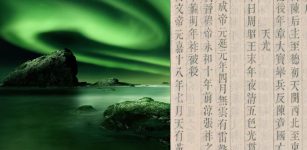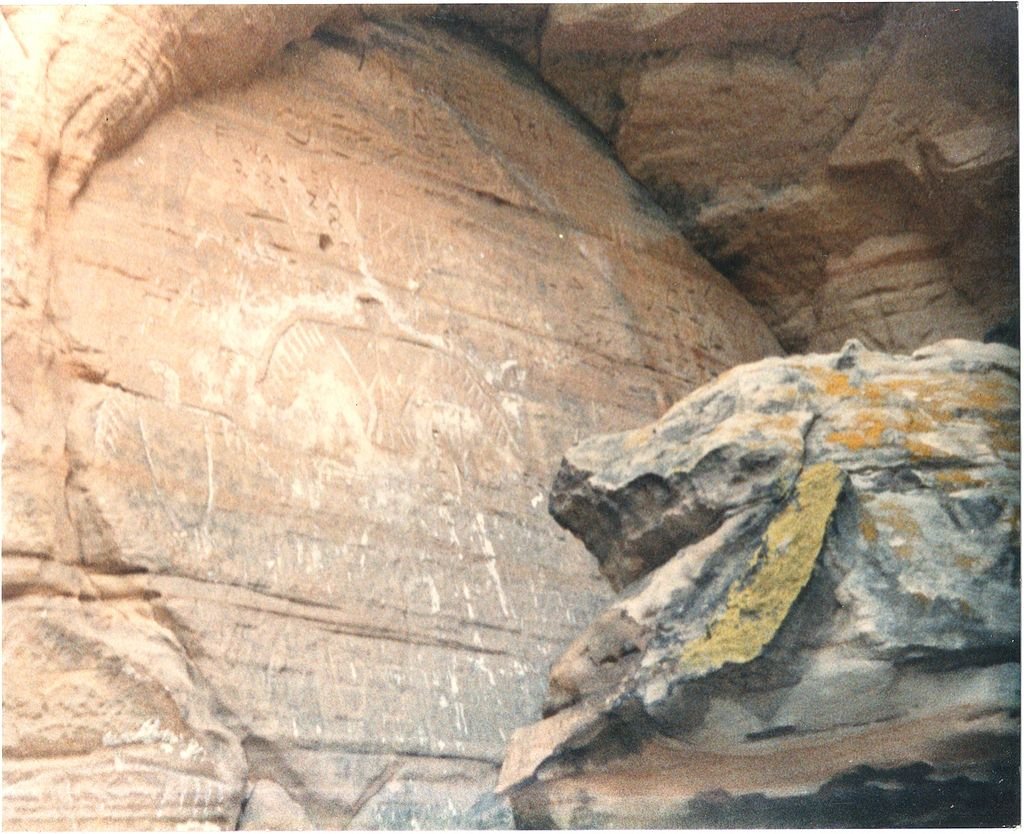Are Thunderbird Petroglyphs In Bighorn Basin Linked To Golden Eagle Nests?
AncientPages.com - In Wyoming's Bighorn Basin there are hundreds of remarkable ancient petroglyphs that were carved thousands of years ago by prehistoric people who lived in the region.
In this region, there are depictions of large human or human-like figures, ancient symbols, geometric patterns and among the stones we find petroglyphs of large birds of prey such as for example the legendary Thunderbird.
There is archaeological evidence that suggests the Thunderbird petroglyphs are linked to Golden Eagle nests, but ancient legends tell a different story.
Native Americans have wonderful legends of a powerful and magnificent Thunderbird that was sent by the Gods to protect humans from evil.
When this huge, eagle-like bird soared the skies, one could hear its mighty wings beat with the sound of rolling thunder. Its eyes were burning like fire and caused lighting.
Is There A Connection Between Thunderbird Petroglyphs And Golden Eagle Nests?
Interestingly, many of the Thunderbird petroglyphs can be found near Golden Eagle nests and this fact has made Bonnie Smith wonder if there could be a connection between these two?
Were the ancient Thunderbird petroglyphs made to depict Golden Eagles?
Bonnie Smith, who is a curatorial assistant of the Draper Natural History Museum has spent years documenting nest sites near petroglyphs depicting Thunderbirds in the Bighorn Basin.

The Bighorn Basin has hundreds of petroglyphs. Bonnie Smith is investigating whether petroglyphs depicting thunderbirds like this one were created near ancient golden eagle nests. (Bonnie Smith)
“I propose that there is a direct correlation between ancient golden eagle nests, Native American eagle traps and thunderbird representations at rock art sites in the Bighorn Basin and the early Native American narrative,” Smith said.
Smith has discovered dozens of nests situated near rock art depicting birds and one eagle trap site with nearby petroglyphs and now she wants to understand why some of them were etched at deliberately chosen sites.
“What if the birds returned to nesting areas through the generations and the petroglyphs portrayed the ancestors of the birds that now live in the area?” Smiths said. “It seemed such an obvious question and connection,” she said.
Archaeological Evidence Vs. Thunderbird Legends
Archaeological evidence does in indeed fit Smith’s theory, but Native American legends of the Thunderbird are not in favor of her research.
To Native Americans, the Eagle is symbol of courage, wisdom and strength. It’s a messenger of the creator and the bird must be treated with respect.
Legends of the Thunderbird tell this enigmatic creature was able to manipulate weather, affecting the winds and creating storms, lightning, thunder, and rain. The Thunderbird is often described as a s shape-shifter who could take the form of humans.
The Quillayute Indians of the Pacific Northwest remember how the Thunderbird was sent by the Great Spirit to help the Indians after a horrible disaster. The Indians had no food and many had died after rain and hail had fallen for many days, destroying all plants. After the rain came snow and the Indians called the Great Spirit for help and it then, he sent people the Thunderbird.
See also:
Mythical Fiery Bird Phoenix In Mythologies Of Many Ancient Cultures
Coyote: Hero, Trickster, Immortal And Respected Animal In Native American Myths
Cannibalistic Shapeshifter Wendigo In Myths And Legends Of The Indians Of North America And Canada
All Native American legends reveal that the Thunderbird made horrible noise when soaring the skies and people feared this mysterious creature as much as they admired it.
Obviously, the ancient Indian account do not fit the description of an eagle’s behavior. So, it’s possible that Thunderbird petroglyphs in Bighorn Basin are not in linked to Golden Eagle nests. It is also thinkable that the petroglyphs Smith has studied do in fact represent Golden Eagles, but and are not depictions of Native Americans’ idea of Thunderbirds.
Perhaps the nature of the Thunderbird is entirely different than we can possibly imagine. What kind of creature can make such horrible noise and change shape at will?
Copyright © AncientPages.com All rights reserved. This material may not be published, broadcast, rewritten or redistributed in whole or part without the express written permission of AncientPages.com
Expand for referencesMore From Ancient Pages
-
 Chankillo: A 2300-Year-Old Solar Observatory in Peru
Civilizations | Sep 2, 2015
Chankillo: A 2300-Year-Old Solar Observatory in Peru
Civilizations | Sep 2, 2015 -
 Why Did People Start Eating Egyptian Mummies? The Weird And Wild Ways Mummy Fever Swept Through Europe
Featured Stories | Jun 7, 2022
Why Did People Start Eating Egyptian Mummies? The Weird And Wild Ways Mummy Fever Swept Through Europe
Featured Stories | Jun 7, 2022 -
 Traces Of Advanced Beings Who Walked Earth Millions Of Years Ago: Controversial Ancient History Examined
Ancient Mysteries | Jun 20, 2018
Traces Of Advanced Beings Who Walked Earth Millions Of Years Ago: Controversial Ancient History Examined
Ancient Mysteries | Jun 20, 2018 -
 Mystery Of The 290-Million-Year-Old Zapata Footprint In New Mexico
Featured Stories | Sep 23, 2020
Mystery Of The 290-Million-Year-Old Zapata Footprint In New Mexico
Featured Stories | Sep 23, 2020 -
 Secret Catacombs With Incredible Ancient Skeletons Covered In Priceless Jewelry
Featured Stories | Nov 20, 2018
Secret Catacombs With Incredible Ancient Skeletons Covered In Priceless Jewelry
Featured Stories | Nov 20, 2018 -
 A Painted Vault Lid Discovered In Royal Palace Of Ek’ Balam Will Shed Light On History Of The Acropolis Of Ek’
Archaeology | Sep 16, 2023
A Painted Vault Lid Discovered In Royal Palace Of Ek’ Balam Will Shed Light On History Of The Acropolis Of Ek’
Archaeology | Sep 16, 2023 -
 Mystery Of 3,000-Year-Old African Civilization Garamantes And Its Ancient Secrets
Archaeology | Feb 16, 2015
Mystery Of 3,000-Year-Old African Civilization Garamantes And Its Ancient Secrets
Archaeology | Feb 16, 2015 -
 Unexplained Lights Over English City Reported By Police May Have A Deeper Meaning
Featured Stories | Dec 11, 2019
Unexplained Lights Over English City Reported By Police May Have A Deeper Meaning
Featured Stories | Dec 11, 2019 -
 How Did 20th-Century Philosophers Explain Ghosts And Other Spooky Subjects?
Featured Stories | Nov 8, 2024
How Did 20th-Century Philosophers Explain Ghosts And Other Spooky Subjects?
Featured Stories | Nov 8, 2024 -
 Roman Forum (‘Forum Romanum’) – The Heart Of Ancient Rome
Featured Stories | Aug 5, 2019
Roman Forum (‘Forum Romanum’) – The Heart Of Ancient Rome
Featured Stories | Aug 5, 2019 -
 Rare Iron Age Crouch Burial Discovered At The Margate Caves Site In Kent, UK
Archaeology | Mar 8, 2018
Rare Iron Age Crouch Burial Discovered At The Margate Caves Site In Kent, UK
Archaeology | Mar 8, 2018 -
 Earliest Record Of An Aurora Discovered In The Bamboo Annals
Archaeology | Apr 15, 2022
Earliest Record Of An Aurora Discovered In The Bamboo Annals
Archaeology | Apr 15, 2022 -
 St. Swithin’s Day And The 40 Days’ Weather Prophecy
Featured Stories | Jul 15, 2023
St. Swithin’s Day And The 40 Days’ Weather Prophecy
Featured Stories | Jul 15, 2023 -
 Blood Discovered On The Shroud Of Turin – Strand Of Jesus’ DNA Can Be Found – Researchers Say
Archaeology | Jul 19, 2017
Blood Discovered On The Shroud Of Turin – Strand Of Jesus’ DNA Can Be Found – Researchers Say
Archaeology | Jul 19, 2017 -
 Fascinating Artifacts Excavated At Harappan Site In Rajasthan, India
Archaeology | Jun 10, 2017
Fascinating Artifacts Excavated At Harappan Site In Rajasthan, India
Archaeology | Jun 10, 2017 -
 Humans Were Living Around Fort McMurray, Alberta 13,000 Years Ago – Scientists Reveal
Archaeology | Aug 3, 2022
Humans Were Living Around Fort McMurray, Alberta 13,000 Years Ago – Scientists Reveal
Archaeology | Aug 3, 2022 -
 Young Girl Finds Rare Ancient Megalodon Shark Tooth On Maryland Beach
Archaeology | Jan 16, 2023
Young Girl Finds Rare Ancient Megalodon Shark Tooth On Maryland Beach
Archaeology | Jan 16, 2023 -
 Exceptional Collection Of Well-Preserved Stucco Masks Of The Mayan Kingdom Reveal Their Secrets
Archaeology | Dec 5, 2022
Exceptional Collection Of Well-Preserved Stucco Masks Of The Mayan Kingdom Reveal Their Secrets
Archaeology | Dec 5, 2022 -
 Monumental Grave Of Ancient Greek Poet Aratus Located In Mersin- But It Cannot Be Opened
Archaeology | Jun 4, 2017
Monumental Grave Of Ancient Greek Poet Aratus Located In Mersin- But It Cannot Be Opened
Archaeology | Jun 4, 2017 -
 Soyal: Hopi Indians’ Winter Solstice Celebration And Arrival Of Katchinas
Ancient Traditions And Customs | Mar 29, 2019
Soyal: Hopi Indians’ Winter Solstice Celebration And Arrival Of Katchinas
Ancient Traditions And Customs | Mar 29, 2019


